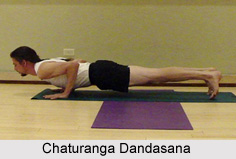 Chaturanga Dandasana is a yoga posture in which a straight body parallel to the ground is supported by the toes and palms, with elbows at a right angle. It is one of the most difficult poses. If Chaturanga is done correctly then it ensures several health benefits. By practicing this yoga asana the strength, balance and stability increases and many muscles are developed. These muscles include the triceps and biceps, pectoralis major in the chest, the abdominal muscles, deltoids muscles, the scapular muscles and rotator cuffs. It is also known as Four-Limbed Staff Pose, Low Plank and Low Push up.
Chaturanga Dandasana is a yoga posture in which a straight body parallel to the ground is supported by the toes and palms, with elbows at a right angle. It is one of the most difficult poses. If Chaturanga is done correctly then it ensures several health benefits. By practicing this yoga asana the strength, balance and stability increases and many muscles are developed. These muscles include the triceps and biceps, pectoralis major in the chest, the abdominal muscles, deltoids muscles, the scapular muscles and rotator cuffs. It is also known as Four-Limbed Staff Pose, Low Plank and Low Push up.
Etymology of Chaturanga Dandasana
The name Chaturanga Dandasana comes from the words "chatur" meaning four, "anga" meaning limb and "danda" meaning staff.
Practice of Chaturanga Dandasana
Chaturanga Dandasana can be practiced anywhere from 10 to 30 seconds. The steps of this asana are as follows-
•From Plank Pose, align the shoulders slightly ahead of the wrists and come onto the balls of feet, pressing the soles of feet towards back. While doing this, the arms should be completely extended and spine should be absolutely straight.
•Now exhale and bend elbows while lowering the body towards the ground. Make sure that the body is parallel to the floor and the hips are straight.
•There should be a broad space between the shoulder blades and ensure that the neck is aligned straight with the rest of body.
•Now press the base of index fingers to the ground. Stay in this position for about 10-30 seconds.
Benefits of Chaturanga Dandasana
•It helps to build the muscles that are necessary to do difficult arm balances.
•It helps to tone arm and hand muscles.
•It develops flexibility and power in the wrists.
•It tones abdominal organs and builds repository muscles.
•It also strengthens the spinal muscles and provides relief from back pain.
Caution about Chaturanga Dandasana
•Those who are pregnant should not practice this asana.
•People suffering from Carpel Tunnel syndrome should also avoid this asana.
•Since it is a difficult asana, the beginners should perform this under the guidance of an expert yoga instructor.




















